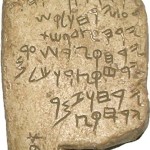
It is very likely that Moses wrote the Torah in the Paleo-Hebrew script. The Paleo-Hebrew script is almost identical to the Early Phoenician script. In the days of the prophet Isaiah, Paleo-Hebrew script was used throughout the land of Canaan (Isaiah in 19:18) and was the main script used until the time of the destruction of the first Temple in Jerusalem by the Babylonians around 586 BCE.
In 539 BCE, the armies of the Persian king Cyrus defeated the Babylonians and afterwards allowed the Jews to return to Jerusalem and rebuild the city and the Temple after their 70 years in exile had been fulfilled. This was the beginning of the Second Temple Period.
After Seventy-years in exile, many of the descendants of those who were taken into exile had forgotten the Hebrew tongue and the Paleo-Hebrew alphabet. The Aramaic alphabet was then adopted for the Hebrew language. Manuscripts (hand written copies) of the Torah and Prophets were developed by scribes in the Aramaic square script (the current Hebrew script) rather then the earlier Paleo-Hebrew script, also known as “Ancient Hebrew”.
Nehemiah records the problems facing the restored Hebrew nation:
“In those days I also saw Jews who had married women of Ashdod, Ammon, and Moab. And half of their children spoke the language of Ashdod, and could not speak the language of Judah, but spoke according to the language of one or the other people.” (Nehemiah 13:23-24)
Charles J. Shields
Now Arise Ministries
